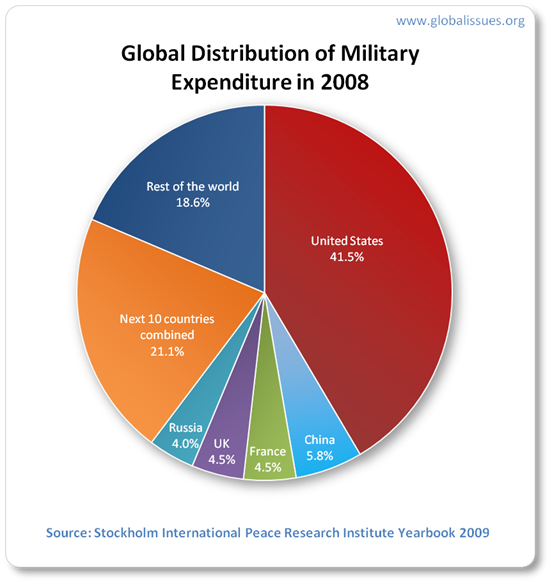Last year, global military spending reportedly exceeded $1.7 trillion – more than $4.6 billion a day, which alone is almost twice the UN’s budget for an entire year.The fact above describes that Military-Industrial-Complex (MIC) – especially in U.S. - still rules the world. Global military industrial consumption represents a few percent of GDP and is still rising. U.S. share of the cake is about 40%. The international community still is willing to invest hundreds of times more to the war than peace. MIC is a concept commonly used to refer to policy relationships between governments, national armed forces, and industrial support they obtain from the commercial sector in political approval for research, development, production, use, and support for military training, weapons, equipment, and facilities within the national defense and security policy.

- U.S. MIC at work
MIC is not only weapons, their development and use, energy companies are one key sector nowadays. The wider picture is that U.S. tries to implement its Silk Road Strategy (SRS) by securing control over extensive oil and gas reserves, as well as “protecting” pipeline routes and trade on Eurasian corridor. This militarization is largely directed against China, Russia and Iran. More about SRS in my article “Is GUUAM dead?”

- Small fraction of U.S. MIC
War activities are producing high quarterly bonuses for owners of military-industrial-complex. Peace work has an opposite problem - it is not profitable, While global military spending is at least $ 1.7 trillion, the OECD Development tries to manage with some 100 billion, Peace work overall gets some 6 billion and 0.6 billion goes to conflict prevention. Peace Research, could help prevent conflicts, but development of tools for killing is much more lucrative. Against one peace researcher, is estimated to be more than 1100 researcher for weapon (and their use) developers.
The difference in what countries are prepared to invest in weapons and their use is huge compared to what they use for example, poverty elimination and economic development in developing countries. And just poverty is one of the causes of violence.

¤ ¤ ¤
Some – Believe or not - Trivia- Congressional Research Service (CRS) Report as of June 2009 in Afghanistan/Iraq theatres operated 73,968 private contractors; included were familiar names like Kellogg, Brown and Root, Fluor Corp, Lockheed Martin and hired guns like DynCorp and Xe (formerly Blackwater USA)
- U.S. spending in Iraq 2003-2006 was 1.4% civilian, 98.6% military
- In Afghanistan, one gallon oil costs the invading troops $ 400 and annual expenditure of one soldier is almost one million US dollar according to a recent statistics.
- U.S. intelligence officials have concluded there are only about 100 al Qaeda fighters in the entire country. With 100,000 troops in Afghanistan at an estimated yearly cost of $30 billion, it means that for every one al Qaeda fighter, the U.S. will commit 1,000 troops and $300 million a year. (Ok there is Taliban too but if I remember right the justification for operation was al Qaeda)
- To keep people happy and silence critics Pentagon spares no effort to keep the media on its side, both in the US and elsewhere. Last years the military allocated at least $4.7 billion per year to “influence operations” and has more than 27,000 employees devoted to such activities.
- The cost of making a Qassam rocket for attacking to Israel is only $ 10-20/each while protecting Israeli civilians with Iron Dome interceptors costs each time $ 40,000 – 100,000.
- Peace Research, could help prevent conflicts, but to kill the development of tools is much more lucrative. Against one peace researcher, is estimated to be more than 1100 researcher for weapon (and their use) developers.

Every
gun that is made, every warship launched, every rocket fired signifies,
in the final sense, a theft from those who hunger and are not fed,
those who are cold and are not clothed…. We pay for a single destroyer
with new homes that could have housed more than 8,000 people…. This is
not a way of life at all, in any true sense.
(President Dwight Eisenhower)

